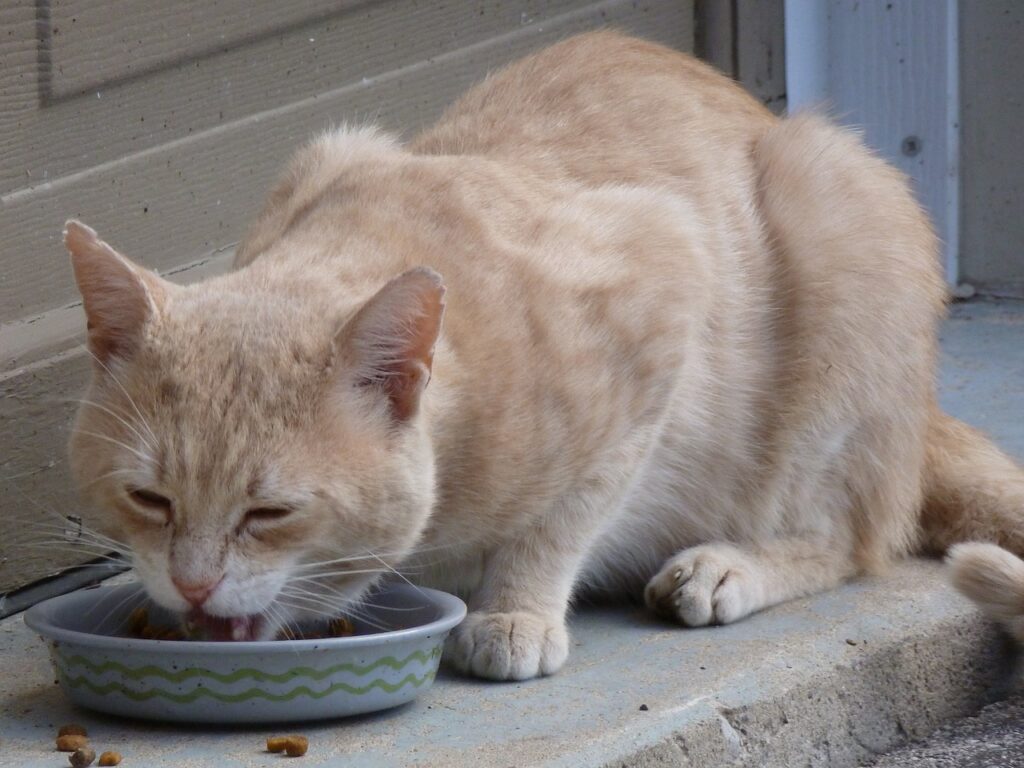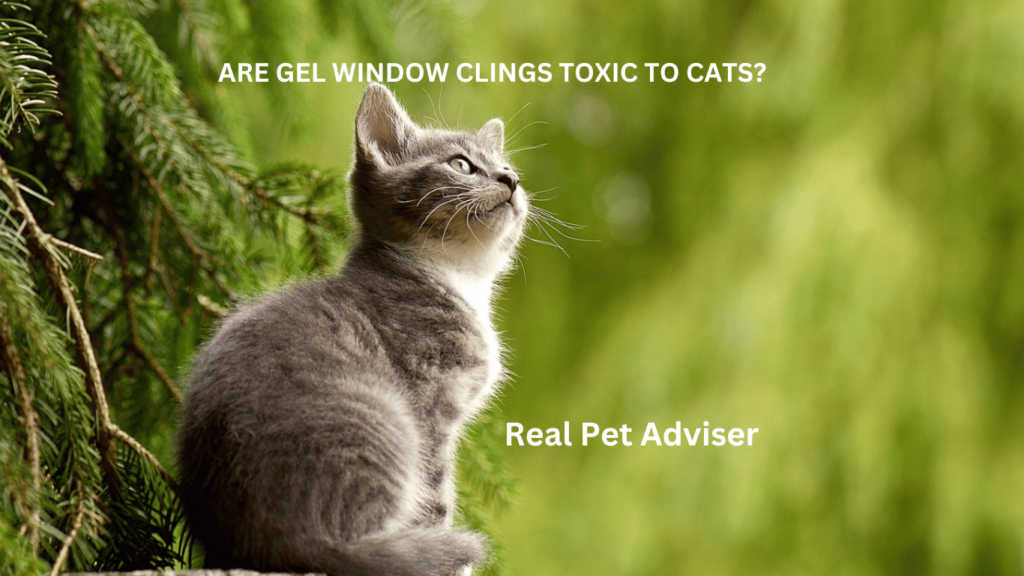Gel window clings have become increasingly popular as a creative way to decorate windows in recent years. Their colorful, sleek designs allow you to easily transform any window into a work of art. However, if you have an adventurous feline friend at home, you may wonder: Are gel window clings toxic to cats?
The good news is that gel window clings are generally considered safe for cats. However, there are a few things you’ll want to keep in mind to help ensure your curious kitty doesn’t get into trouble with these decorative items.
In this article, we’ll cover everything you need to know about how to keep your cat safe around gel window clings. So, let’s explore the safety considerations for using gel window clings if you have a cat!
You May Also Like: CAN CATS EAT ROTISSERIE CHICKEN?
Table of Contents
What Are Gel Window Clings?

Before diving into gel cling safety, let’s quickly cover what these products are. Gel window clings are decorative plastic sheets that stick to windows. They come in a variety of colors, shapes, and designs.
Some popular options include:
- Seasonal shapes (pumpkins, snowflakes, etc.)
- Holiday themes
- Rainbows, shapes, and colors
- Silhouettes of trees, flowers, animals, etc.
Gel clings adhere smoothly to windows via static cling, meaning there’s no adhesive required. Their gel-like plastic material uses the power of static electricity to “cling” tightly to glass.
Gel clings are simpler to put on, take off, and use again than regular window stickers. Their smooth surface stops dust and dirt from collecting on them.
Overall, gel window clings provide an easy, versatile way to decorate windows or create privacy without damaging surfaces or leaving behind a sticky residue. But how safe are they for curious cats?
Are Gel Window Clings Toxic to Cats?

Here’s the good news: Gel window clings are generally non-toxic for cats.
The thin, flexible plastic material used to make most window gel clings is considered safe if chewed or ingested. However, they present a potential choking hazard to cats and dogs.
Small pieces chewed off larger clings can become lodged in a pet’s throat or intestines. Cats are especially prone to chewing and swallowing non-food items, so gel clings may appeal to your cat as a colorful chewing toy.
Additionally, the dyes used to color gel clings could cause stomach upset if ingested in large amounts.
So, gel clings are not inherently poisonous, but they pose safety risks for pets if swallowed. Supervision and preventative measures are recommended when using window gel clings in homes with cats.
How to Keep Your Cat Safe from Gel Window Clings
While gel clings don’t contain toxic compounds, your cat could still be tempted to chew on or play with these interesting decorations. Here are some tips to keep your cat safe around gel window clings.
You May Also Like: CAN CATS EAT RANCH DRESSING?
Use Pet-Safe Window Clings
Look for window clings made specifically for pets or children. These are designed with safe, non-toxic materials that are not toxic if ingested by animals.
KidCo makes pet-approved gel clings, for example. Getting clings made for pet owners can provide peace of mind about their safety.
Apply Clings Securely
Apply gel clings to windows according to the package instructions to get the best, most secure cling. Most brands advise cleaning the window thoroughly before application to remove dust and oils for optimal cling.
Apply clings on dry windows without steam or condensation as well. Wrinkles or trapped air bubbles can make edges more likely to peel and create chewing hazards.
Also, check clings periodically to ensure they stay fully adhered to. Reapply any loose edges promptly before the kitty can pick at them.
Place Clings Out of Reach
Put gel window clings completely out of your cat’s reach whenever possible. Placing clings on higher windows prevents pawing, chewing, or batting.
Avoid low windows or sliding glass doors that curious kitties could access. You can also apply clings to the outside of windows instead of inside.
Keep an Eye on Your Cat
Closely supervise your cat around any window gel clings, especially when first applied. Monitor their reaction and interest level. You can step in as soon as you see the dog starting to chew.
Continue checking on clings daily and watching for broken or separated pieces that need replacement. Don’t allow unattended access.
Use deterrents like aluminium foil, double-sided tape, or repellent sprays on window frames if your cat persistently tries to access clings.
Redirect Chewing Behavior
If your cat is intent on chewing gel clings, redirect their energy towards safer alternatives. Offer plenty of cat-approved toys, scratching posts, and chew items.
Place a cat tree or climbing tower near clinging-decorated windows to entice them toward appropriate scratching and climbing instead of chewing.
Use treats, catnip, and playtime to reward and reinforce desired behaviors. To prevent boredom and keep them from being tempted by window clings, Keep them engaged and occupied.
With vigilance and training, you can satisfy your cat’s chewing urges in safer, healthier ways.
What To Do If Your Cat Ate a Gel Window Cling
If your cat managed to ingest pieces of a gel window cling, don’t panic. Here’s what to do:
- Monitor them closely for signs of intestinal blockage or distress like vomiting, diarrhea, loss of appetite, or lethargy. Trouble breathing can indicate airway obstruction.
- Contact your vet if you notice any concerning symptoms. Describe what they ingested and how much.
- The vet may recommend bringing your cat in for an exam and X-rays to check for intestinal blockages or gel cling pieces trapped in the throat or esophagus.
- Feed a high-fiber diet and supplement with probiotics to support healthy digestion and the passage of the gel through the GI tract. Increase your cat’s water intake as well.
- Avoid any stringy, chewy foods that could tangle with cling remnants in the intestines. Stick with easily digestible, wet foods.
- Watch closely for proper bowel movements to ensure the ingested item passes fully.
- See the vet promptly if you notice vomiting, no bowel movements, loss of appetite, or other troubling symptoms indicating a potential intestinal obstruction. Surgery may be required in severe cases.
With quick action and vet monitoring, minor ingestion of a gel window cling often passes through the body safely. Still, medical attention is crucial if symptoms arise or a blockage is suspected.
Conclusion: Are gel window clings toxic to cats?
Gel window clings can be used safely in homes with cats when care is taken to monitor behavior and prevent chewing, clawing, or ingestion. With simple precautions, your decor and your cat can stay safe!
So don’t let worries about window cling safety deter you from decorating with these festive products – just be sure to put your cat’s safety first. With mindfulness and training, gel clings can be a fun addition to your home, even with a kitty running around!
FAQs: Are gel window clings toxic to cats?
Still have some questions about using gel window clings safely when you have a cat? Here are answers to some frequently asked questions:
Are gel window clings toxic to cats if licked or chewed?
No, the gel plastic itself is non-toxic. However, chewing and swallowing pieces pose a choking/blockage risk.
Can cats scratch gel window clings?
Yes, cats may try scratching at clings on windows. Proper application and placement can help deter this.
Do gel window clings leave any residue or damage windows?
No, gel clings use static cling, so they don’t leave behind any sticky residue or harm windows.
Should you put gel clings inside or outside windows with cats?
Outside is safer, but indoor applications work if clings are out of reach and cats are supervised.
What if my cat eats a large piece of window gel cling film?
Promptly contact your vet, as large pieces can obstruct the intestines. Surgery may be needed to remove it.
Can I use gel window clings in rooms my cat accesses?
Yes, with proper precautions like supervised access and distraction and redirection techniques.







